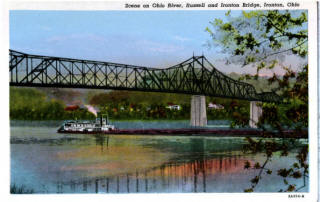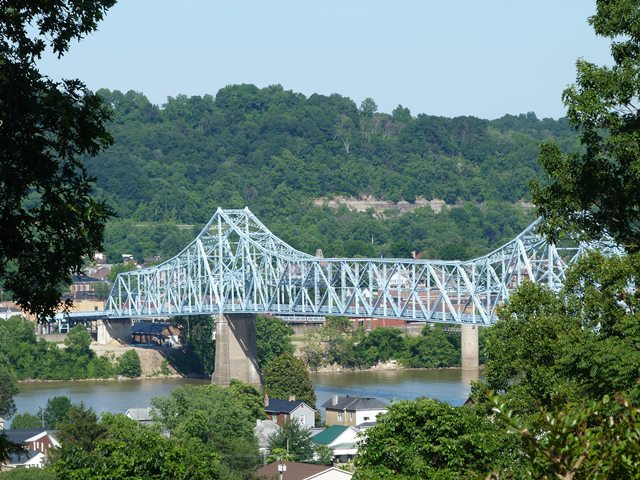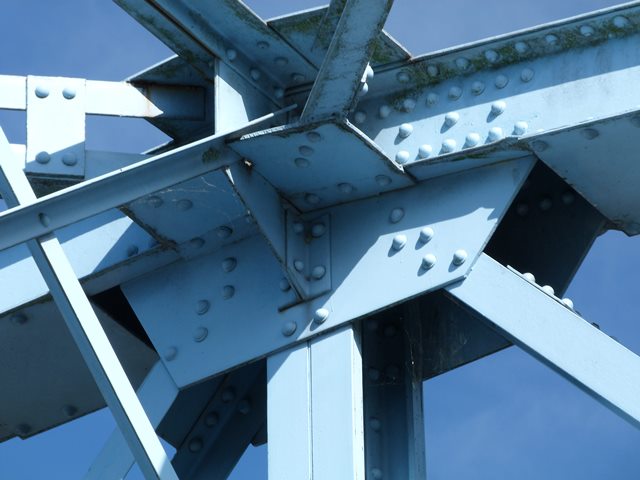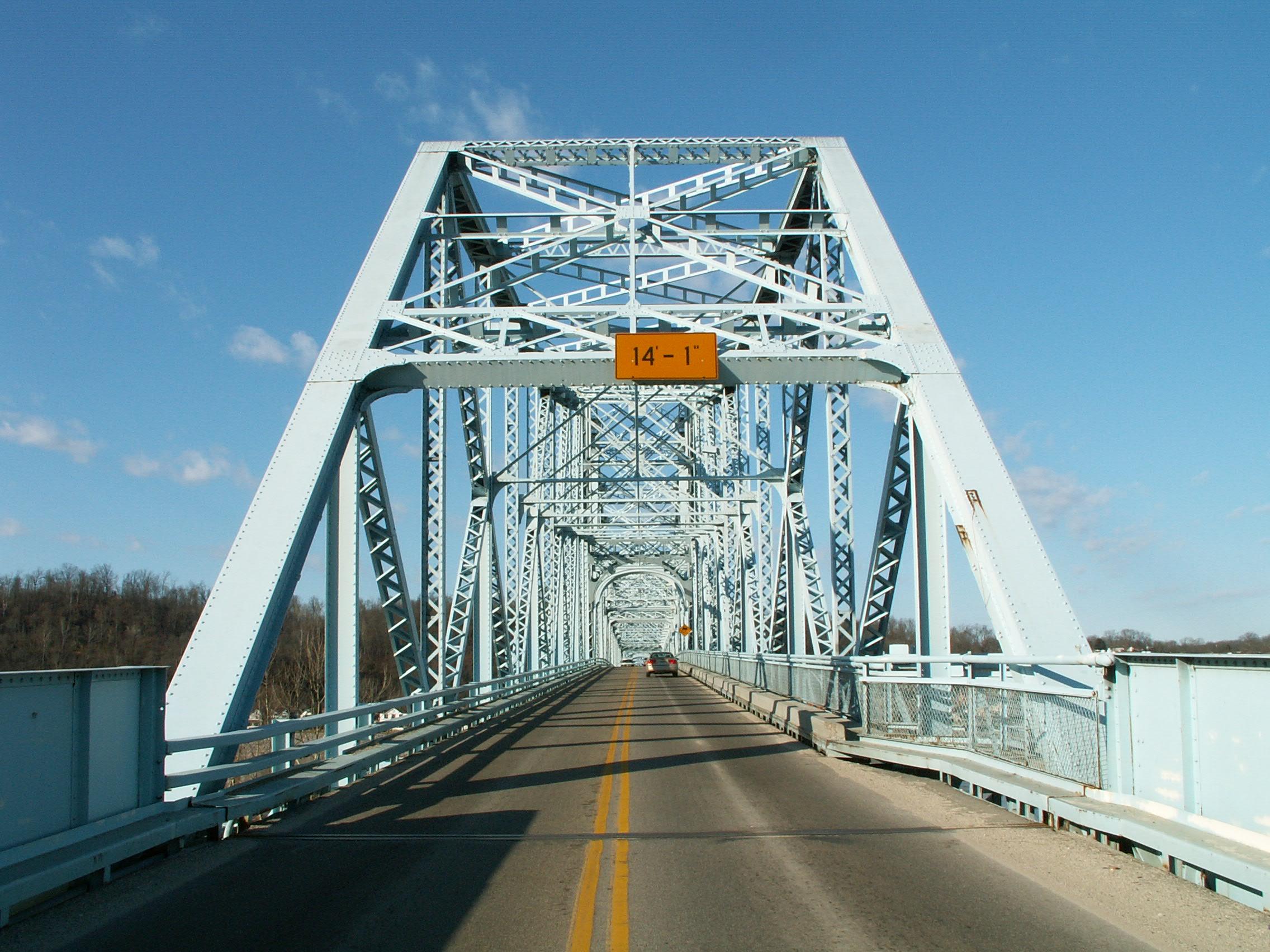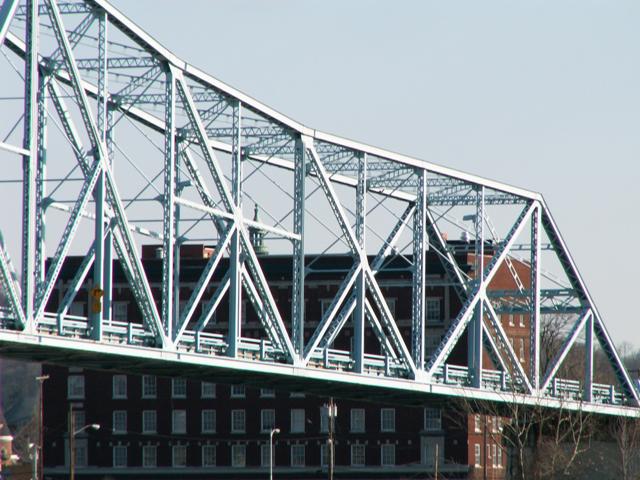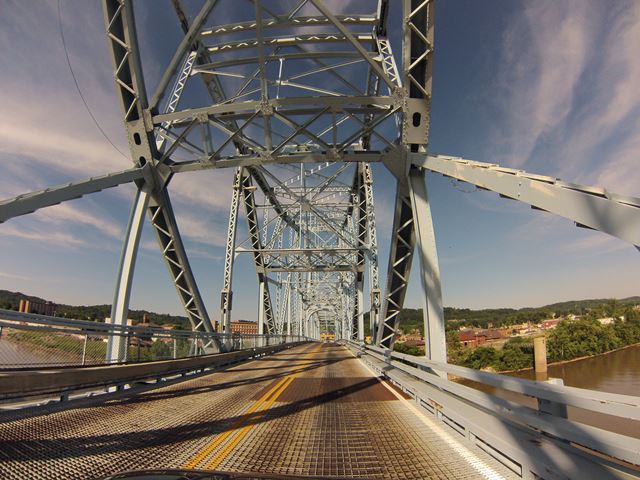We Recommend:
Bach Steel - Experts at historic truss bridge restoration.
BridgeHunter.com Phase 1 is released to the public! - Visit Now
Ironton-Russell Bridge

Primary Photographer(s): Nathan Holth and Rick McOmber
Bridge Documented: March 3, 2007 and June 7, 2014
Ironton and Russell: Greenup County, Kentucky and Lawrence County, Ohio: United States
Metal Cantilever 24 Panel Rivet-Connected Baltimore Through Truss, Fixed and Approach Spans: Metal 7 Panel Rivet-Connected Camelback Through Truss, Fixed
1922 By Builder/Contractor: Wisconsin Bridge and Iron Company of Milwaukee, Wisconsin
1962
725.0 Feet (221 Meters)
2,401.0 Feet (731.8 Meters)
21 Feet (6.4 Meters)
3 Main Span(s) and 27 Approach Span(s)
4401255

View Information About HSR Ratings
Bridge Documentation
This bridge no longer exists!
This bridge's song is:
View Archived National Bridge Inventory Report - Has Additional Details and Evaluation
View Original and Major Rehab Plans For This Bridge (Large File)
View Historical Articles About This Bridge
Historic Significance and Beauty of the Ironton Russell Bridge

This magnificent cantilever bridge is a beautiful historic monument, uniting the towns of Ironton and Russell. The bridge features a traditional three span cantilever truss for its main spans (including a suspended Baltimore truss span in the central channel span), while at the Kentucky end, there is also a single simple riveted Camelback through truss span. Additionally, at each end of the bridge there is a system of simple approach spans that provide an unusual approach that include a 90 degree turn as part of their design. At the Ohio end, the western end of the approach ramp is composed of riveted deck and through plate girder spans (right where the 90 degree angle occurs) which appear to be original... however the remaining spans of the ramps at each end of the bridge are a variety of steel and concrete spans which do not appear to be original to the bridge.
The bridge is also noted for a couple unusual details. The main posts of the bridge (the two tallest vertical members located at the center of the bridge "towers") are of an interesting variable depth design where the built-up beam is wider at the mid-height of the main post, as opposed to the top and bottom. Also, the system of hanging the suspended span is unusual because there appear to be two hangers for the suspended span at each end instead of the typical one. The second hanger connects halfway up the end post of the suspended span. This design appears to accommodate the Baltimore truss configuration of the suspended span which results in a longer end post with a more shallow slope that essentially is two panels long.
Large cantilever bridges were built throughout the 20th Century, and remained a popular option for large river crossings until the late 20th Century when the cable-stayed bridge took off as the preferred option. Overall, the structure type did not change much over the years, which might lead some to believe that a bridge like the Ironton Bridge is not historically significant because its type was continued to be built up to such a recent date. Nothing could be further from the truth. Although the overall structure type remained in use, the methods of construction, materials used, design details, and complexity of the trusses changed vastly, making older surviving examples extremely important historic artifacts with high levels of historical and technological significance. Compared to newer cantilever truss bridges, the Ironton-Russell Bridge has a much more complex network of trusses and bracing. Newer bridges might be larger and wider, but they actually have less sway bracing and truss elements, using smaller numbers of larger, stronger members to do the job that many smaller members do on a bridge like the Ironton-Russell Bridge. This complex network of trusses on the Ironton-Russell Bridge show the extent of the engineering and erection work that was needed to build this bridge. Thus, this suggests the historic importance of the Ironton-Russell Bridge as an engineering feat. This network of trusses and bracing also creates a more beautiful structure with a complex geometric art that is a pleasure to look at and an exciting experience to cross. In addition, the Ironton Russell is even more visually impressive for its use of built-up members and chords that utilize v-lacing and lattice... a typical practice of the period. Built-up members were used to form large structural steel elements, at a time when rolling an i-beam of that size was impossible or inefficient. Built-up beams on older truss bridges (generally, pre-1940) will usually feature extensive v-lacing and lattice, which was to hold the parts of the built-up beams together, but also creates a strong aesthetic element to the bridge as well. Since built-up beams do not appear on modern bridges, truss bridges should be considered historically significant for their use of built-up beams. For all the reasons above, relatively old cantilever truss bridges, such as the 1922 Ironton-Russell Bridge, are historic and are worthy of preservation. The Ironton Russell Bridge also has high historic significance in the context of the Ohio River. It was the first bridge built between Cincinnati, OH and Parkersburg, WV... a rather long distance to not have any bridges. Additionally, the bridge is the oldest surviving bridge of its type on the entire Ohio River! Indeed, among surviving highway cantilever truss bridges nationwide, this bridge is a very old surviving example in the United States.

Replacement of the Bridge Including Pointless Demolition of the Historic Bridge
There is no denying that the historic Ironton Russell Bridge has some problems. The narrow roadway combined with the unusual approaches that include 90 degree turns right on the bridge makes the historic bridge somewhat inefficient and difficult for trucks to use. Additionally, the bridge has an unusual situation where its steel was found to be more brittle than typical steel found in bridges... and worse someone improperly welded plates to the bridge in a shoddy repair in the 1970s which only made the problem worse. As such, the bridge has to close to traffic when it gets very cold out in the winter because of these problems and concerns that weight on the bridge when it is this cold could make the problem worse.
Given the above problems it is perhaps unsurprising that ODOT (the lead agency for this state line bridge) decided to construct a new bridge to meet the needs of vehicular traffic in the area. A completely new alignment, nearly a half mile south of the historic bridge was selected for the replacement bridge. The new alignment should eliminate the unusual approach system for the bridge and also eliminate the unusual path through Ironton and Russell that travelers must take to get over the bridge.
Given the iconic beauty and historic significance of the historic bridge, and the fact that all the aforementioned problems with the bridge are only a concern with vehicular traffic and do not affect the bridge's ability to carry pedestrian traffic, common sense suggests that it would go without saying that the historic bridge would be left standing to carry pedestrian and non-motorized traffic. Unfortunately, common sense is sorely lacking in the way decisions are made regarding historic bridges in the United States and that is made quite clear with this bridge's fate. Despite the fact that the bridge would have no problem safely carrying pedestrians for decades in its current condition, and despite the fact that the bridge is not in the way of its replacement and is in fact a half mile away, this historic bridge will be demolished when the replacement is complete! That is right... millions of taxpayer dollars will be wasted for no other purpose than to reduce one of the most beautiful and historic bridges on the Ohio River to a pile of scrap metal! The money used to demolish this bridge could have been saved and used for something else more useful, or perhaps saved for future enhancements to the historic Ironton-Russell Bridge in what would be its new purpose as a non-motorized crossing.
Above: 1930s postcard of bridge.

Replacement Structure: A Wired Slab of Concrete
Maybe when they were new, and there were only a few in the country these cable-stayed bridges might have been interesting. But now there are so many of them they are not unique. And regardless of whether or not someone might think the cables or towers might be visually interesting, nobody can deny that the entire deck and supporting deck stringers as well as the substructure are no more than the typical ugly prestressed concrete bridges that plague so many smaller rivers and crossings in this country today. Drawing and renderings from the design plans are shown below.
Finally, the below rendering is the draft of the interpretive signage that is intended to fill the void left behind by the pointless demolition of the landmark historic bridge. The sign conveniently omits the fact that the construction of the new bridge did not require the demolition of the historic bridge.
![]()
Photo Galleries and Videos: Ironton-Russell Bridge
2014 Structure Overview and Details Part 1
Original / Full Size PhotosA collection of overview photos that show the bridge as a whole and general areas of the bridge and a collection of detail photos that document the parts, construction, and condition of the cantilever arms, anchor arms, and suspended span hanger system. This gallery offers photos in the highest available resolution and file size in a touch-friendly popup viewer.
Alternatively, Browse Without Using Viewer
![]()
2014 Structure Details Part 2
Original / Full Size PhotosA collection of detail photos that document the parts, construction, and condition of the remainder of the bridge including suspended span, approach spans, and substructure. This gallery offers photos in the highest available resolution and file size in a touch-friendly popup viewer.
Alternatively, Browse Without Using Viewer
![]()
2014 Structure Overview and Details Part 1
Mobile Optimized PhotosA collection of overview photos that show the bridge as a whole and general areas of the bridge and a collection of detail photos that document the parts, construction, and condition of the cantilever arms, anchor arms, and suspended span hanger system. This gallery features data-friendly, fast-loading photos in a touch-friendly popup viewer.
Alternatively, Browse Without Using Viewer
![]()
2014 Structure Details Part 2
Mobile Optimized PhotosA collection of detail photos that document the parts, construction, and condition of the remainder of the bridge including suspended span, approach spans, and substructure. This gallery features data-friendly, fast-loading photos in a touch-friendly popup viewer.
Alternatively, Browse Without Using Viewer
![]()
2007 Original / Full Size Gallery
Original / Full Size PhotosFor the best visual immersion and full detail, or for use as a desktop background, this gallery presents selected overview and detail photos for this bridge in the original digital camera resolution. This gallery offers photos in the highest available resolution and file size in a touch-friendly popup viewer.
Alternatively, Browse Without Using Viewer
![]()
2007 Structure Overview
Mobile Optimized PhotosA collection of overview photos that show the bridge as a whole and general areas of the bridge. This gallery features data-friendly, fast-loading photos in a touch-friendly popup viewer.
Alternatively, Browse Without Using Viewer
![]()
2007 Structure Details
Mobile Optimized PhotosA collection of detail photos that document the parts, construction, and condition of the bridge. This gallery features data-friendly, fast-loading photos in a touch-friendly popup viewer.
Alternatively, Browse Without Using Viewer
![]()
Crossing The Bridge
Original / Full Size PhotosA series of photos taken with a high resolution, wide angle GoPro camera showing the experiance of driving over the bridge. This gallery offers photos in the highest available resolution and file size in a touch-friendly popup viewer.
Alternatively, Browse Without Using Viewer
![]()
Crossing The Bridge
Mobile Optimized PhotosA series of photos taken with a high resolution, wide angle GoPro camera showing the experiance of driving over the bridge. This gallery features data-friendly, fast-loading photos in a touch-friendly popup viewer.
Alternatively, Browse Without Using Viewer
![]()
CarCam: Eastbound Crossing
Full Motion VideoNote: The downloadable high quality version of this video (available on the video page) is well worth the download since it offers excellent 1080 HD detail and is vastly more impressive than the compressed streaming video. Streaming video of the bridge. Also includes a higher quality downloadable video for greater clarity or offline viewing.
![]()
CarCam: Westbound Crossing
Full Motion VideoNote: The downloadable high quality version of this video (available on the video page) is well worth the download since it offers excellent 1080 HD detail and is vastly more impressive than the compressed streaming video. Streaming video of the bridge. Also includes a higher quality downloadable video for greater clarity or offline viewing.
![]()
Maps and Links: Ironton-Russell Bridge
This historic bridge has been demolished. This map is shown for reference purposes only.
Coordinates (Latitude, Longitude):
Search For Additional Bridge Listings:
Bridgehunter.com: View listed bridges within 0.5 miles (0.8 kilometers) of this bridge.
Bridgehunter.com: View listed bridges within 10 miles (16 kilometers) of this bridge.
Additional Maps:
Google Streetview (If Available)
GeoHack (Additional Links and Coordinates)
Apple Maps (Via DuckDuckGo Search)
Apple Maps (Apple devices only)
Android: Open Location In Your Map or GPS App
Flickr Gallery (Find Nearby Photos)
Wikimedia Commons (Find Nearby Photos)
Directions Via Sygic For Android
Directions Via Sygic For iOS and Android Dolphin Browser
USGS National Map (United States Only)
Historical USGS Topo Maps (United States Only)
Historic Aerials (United States Only)
CalTopo Maps (United States Only)


